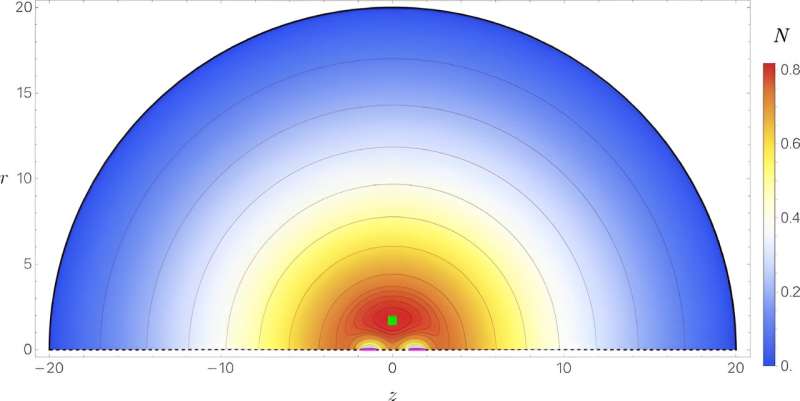October 5, 2023 report
This article has been reviewed according to Science X's editorial process and policies. Editors have highlighted the following attributes while ensuring the content's credibility:
fact-checked
peer-reviewed publication
trusted source
proofread
Researchers suggest paired black holes pulled by cosmic expansion could seem to be one entity

A small team of astrophysicists and mathematicians from the University of Southampton, the University of Cambridge and Institut de Ci'encies del Cosmos Universitat de Barcelona has proposed that certain pairings of black holes held apart by cosmic expansion could be mistaken for a single equal-mass black hole.
In their paper published in the journal Physical Review Letters, the group explains why such a pairing, despite theorems that show such binary solutions could not exist, would not violate Einstein's theory of general relativity.
Prior research has shown that there is just one solution to Einstein's theory of relativity as it relates to black holes. Such findings have suggested that black holes must therefore all be identical. But more recent research has shown that there are exceptions that can be made without violating the single equation theory. The single equation theory only applies, for example, in scenarios where there is no other energy that can impact the system.
Such systems would of necessity also be in a state of equilibrium, which means they would be neither moving, nor rotating. Thus, an instance where a black hole consumed charged matter, resulting in a field activating around the black hole, would not be accounted for by the single formula. It would be explained by other theorems, however.
Another interesting case is the situation of two black holes that repel each other in ways that are exactly equal to their gravitational attraction—they would exist at a certain distance from one another, unable to move more closely together or farther apart. Under such a scenario, it has been shown that the two black holes would be indistinguishable from a single black hole, which would allow them to be considered as a single entity when using the single solution formula covered under general relativity.
In this new effort, the researchers have found a similar situation for a pair of black holes that are pulled together by gravity, but are also pulled apart in equal measure by cosmic expansion. Thus, they too would be held in permanent stasis. In this case, the research team has shown via complicated math involving black holes with opposite spins that such an arrangement could exist and that it would not violate general relativity because it could be counted as a single entity, though for different reasons.
More information: Óscar J. C. Dias et al, Static Black Binaries in de Sitter Space, Physical Review Letters (2023). DOI: 10.1103/PhysRevLett.131.131401
Journal information: Physical Review Letters
© 2023 Science X Network





















